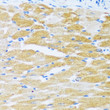| Tissue Specificity | Isoform 1 is widely expressed in smooth muscle and nonmuscle tissues such as in adult skin epidermis, with highest expression in liver, pancreas and lung, and intermediate expression in brain, kidney and placenta. Also expressed at lower levels in heart and skeletal muscle. Isoforms 2 and 3 are highly expressed in the heart and slow twitch skeletal muscle. Expression of isoform 3 is predominantly restricted to cardiomyocytes and in close proximity to the sarcolemma. Both isoforms are mildly expressed in lung, kidney, liver, pancreas and placenta. Expression of isoform 3 is amplified during monocytic differentiation and also observed in the fetal heart. |
| Post Translational Modifications | Nitrated under oxidative stress. Nitration on the two tyrosine residues inhibits catalytic activity. Serotonylated on Gln residues by TGM2 in response to hypoxia, leading to its inactivation. |
| Function | This magnesium-dependent enzyme catalyzes the hydrolysis of ATP coupled with the translocation of calcium from the cytosol to the sarcoplasmic reticulum lumen. Involved in autophagy in response to starvation. Upon interaction with VMP1 and activation, controls ER-isolation membrane contacts for autophagosome formation. Also modulates ER contacts with lipid droplets, mitochondria and endosomes. In coordination with FLVCR2 mediates heme-stimulated switching from mitochondrial ATP synthesis to thermogenesis. Isoform 2: Involved in the regulation of the contraction/relaxation cycle. Acts as a regulator of TNFSF11-mediated Ca(2+) signaling pathways via its interaction with TMEM64 which is critical for the TNFSF11-induced CREB1 activation and mitochondrial ROS generation necessary for proper osteoclast generation. Association between TMEM64 and SERCA2 in the ER leads to cytosolic Ca(2+) spiking for activation of NFATC1 and production of mitochondrial ROS, thereby triggering Ca(2+) signaling cascades that promote osteoclast differentiation and activation. |
| Protein Name | Sarcoplasmic/Endoplasmic Reticulum Calcium Atpase 2Serca2Sr Ca(2+-Atpase 2Calcium Pump 2Calcium-Transporting Atpase Sarcoplasmic Reticulum Type - Slow Twitch Skeletal Muscle IsoformEndoplasmic Reticulum Class 1/2 Ca(2+ Atpase |
| Database Links | Reactome: R-HSA-1912420Reactome: R-HSA-418359Reactome: R-HSA-5578775Reactome: R-HSA-936837 |
| Cellular Localisation | Endoplasmic Reticulum MembraneMulti-Pass Membrane ProteinSarcoplasmic Reticulum MembraneColocalizes With Flvcr2 At The Mitochondrial-Er Contact Junction |
| Alternative Antibody Names | Anti-Sarcoplasmic/Endoplasmic Reticulum Calcium Atpase 2 antibodyAnti-Serca2 antibodyAnti-Sr Ca(2+-Atpase 2 antibodyAnti-Calcium Pump 2 antibodyAnti-Calcium-Transporting Atpase Sarcoplasmic Reticulum Type - Slow Twitch Skeletal Muscle Isoform antibodyAnti-Endoplasmic Reticulum Class 1/2 Ca(2+ Atpase antibodyAnti-ATP2A2 antibodyAnti-ATP2B antibody |
Information sourced from Uniprot.org











